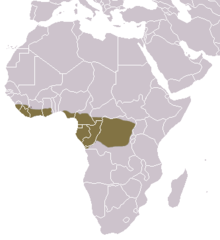This article includes a list of general references, but it lacks sufficient corresponding inline citations. (August 2016) |
| Long-tailed pangolin | |
|---|---|

| |
| Individual at Dzanga-Sangha Reserve in the Central African Republic | |
| Scientific classification | |
| Domain: | Eukaryota |
| Kingdom: | Animalia |
| Phylum: | Chordata |
| Class: | Mammalia |
| Order: | Pholidota |
| Family: | Manidae |
| Genus: | Phataginus |
| Species: | P. tetradactyla
|
| Binomial name | |
| Phataginus tetradactyla | |

| |
| Long-tailed pangolin range | |
| Synonyms | |
| |
The long-tailed pangolin (Phataginus tetradactyla), also called the African black-bellied pangolin or ipi,[4] is a diurnal, arboreal pangolin species belonging to the family Manidae, in the order Pholidota. They feed on ants rather than termites. The common names for this species stem from physical characteristics, such as the extremely long tail or the dark hairs that cover the underside of their bodies and limbs. Pangolin comes from the Malay word pengguling, meaning “something that rolls up”.
- ^ Ingram, D.J.; Shirley, M.H.; Pietersen, D.; Godwill Ichu, I.; Sodeinde, O.; Moumbolou, C.; Hoffmann, M.; Gudehus, M.; Challender, D. (2019). "Phataginus tetradactyla". IUCN Red List of Threatened Species. 2019: e.T12766A123586126. doi:10.2305/IUCN.UK.2019-3.RLTS.T12766A123586126.en. Retrieved 19 November 2021.
- ^ "Appendices | CITES". cites.org. Retrieved 2022-01-14.
- ^ Gaudin, Timothy (28 August 2009). "The Phylogeny of Living and Extinct Pangolins (Mammalia, Pholidota) and Associated Taxa: A Morphology Based Analysis" (PDF). Journal of Mammalian Evolution. 16 (4): 235–305. doi:10.1007/s10914-009-9119-9. S2CID 1773698. Archived from the original (PDF) on 25 September 2015. Retrieved 14 May 2015.
- ^ Dictionary.die.net
